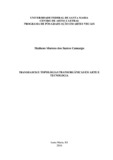| dc.creator | Camargo, Matheus Moreno dos Santos | |
| dc.date.accessioned | 2016-10-03 | |
| dc.date.available | 2016-10-03 | |
| dc.date.issued | 2016-08-31 | |
| dc.identifier.citation | CAMARGO, Matheus Moreno dos Santos. TRANSHABITAT: TRANSORGANICS TOPOLOGIES IN ART AND TECHNOLOGY. 2016. 143 f. Dissertação (Mestrado em Artes) - Universidade Federal de Santa Maria, Santa Maria, 2016. | por |
| dc.identifier.uri | http://repositorio.ufsm.br/handle/1/5247 | |
| dc.description.abstract | The poetical research Transhabitat proposes other communicative ways of inhabiting in the context of Art and Technology. With the accomplishment of interactive installations, it problematizes the definition of topology from the concepts of cybrid proposed by Peters Anders (1997), and of transorganic, presented by Di Felice (2009). In the transorganic environments that were built, the spacial configurations are stablished through the informational flow and hybrid connections of the physical space and cyberspace, also named cybrids informations, whose observer-interactor connect autopoetically. These topologies are present in occasional diagrams, processes of virtualization and updating of the space surfaces, and are provided from the interaction between complex systems data in several scales, resulting in interactive images which connect the individual to the transorganic habitats through local actions interconnected by network. The generative topologies proposed in this research, by being constituted of layers of dynamic standard and transmutable surfaces generate spacial expansion with the inclusion of movements and possible times in the hyperspace, where the individuals interact in real time with the habitats proposed. In this way, Transhabitat is constituted by transorganic, interactive and connected habitats which aim at provoking spacial hybridisation in cybrids relations among individuals and environments, in an organism of data and flow of information. | eng |
| dc.description.sponsorship | Coordenação de Aperfeiçoamento de Pessoal de Nível Superior | |
| dc.format | application/pdf | por |
| dc.language | por | por |
| dc.publisher | Universidade Federal de Santa Maria | por |
| dc.rights | Acesso Aberto | por |
| dc.subject | Transhabitat | por |
| dc.subject | Topologia | por |
| dc.subject | Transorgânico | por |
| dc.subject | Arte e tecnologia | por |
| dc.subject | Interatividade | por |
| dc.subject | Transhabitat | eng |
| dc.subject | Topology | eng |
| dc.subject | Transorganic | eng |
| dc.subject | Art and technology | eng |
| dc.subject | Interactivity | eng |
| dc.title | Transhabitat: topologias transorgânicas em arte e tecnologia | por |
| dc.title.alternative | Transhabitat: transorganics topologies in art and technology | eng |
| dc.type | Dissertação | por |
| dc.description.resumo | A pesquisa poética Transhabitat propõe outros modos comunicativos de habitar no contexto da Arte e Tecnologia. Com a realização de instalações interativas, problematiza-se a definição de topologia a partir dos conceitos de cíbrido , proposto por Peter Anders (1997), e de transorgânico , apresentado por Di Felice (2009). Nos ambientes transorgânicos construídos, as configurações espaciais se estabelecem através de fluxos informacionais e conexões híbridas do espaço físico e do ciberespaço, também denominadas informações cíbridas, aos quais o observador-interator conecta-se autopoieticamente. Essas topologias são visíveis em diagramas eventuais, processos de virtualização e de atualização das superfícies do espaço, e provêm das interações entre dados de sistemas complexos em diversas escalas, resultando em imagens interativas, que conectam o indivíduo aos hábitats transorgânicos através de ações locais interconectadas em rede. As topologias generativas propostas nessa pesquisa, por se constituirem de camadas de padrões dinâmicos e superfícies trasmutáveis, geram expansões espaciais com a adição de movimentos e tempos possíveis num hiperespaço, onde os indivíduos interagem em tempo real com os hábitats propostos. Desse modo, Transhabitat é constituído de habitats transorgânicos, interativos e conectados, que visam provocar hibridizações espaciais em relações cíbridas, entre indivíduos e ambientes, em um organismo de dados e informações em fluxo Interatividade. | por |
| dc.contributor.advisor1 | Oliveira, Andréia Machado | |
| dc.contributor.advisor1Lattes | http://lattes.cnpq.br/7243757837987821 | por |
| dc.contributor.referee1 | Minuzzi, Reinilda de Fátima Berguenmayer | |
| dc.contributor.referee1Lattes | http://buscatextual.cnpq.br/buscatextual/visualizacv.do?id=K4770857Y8 | por |
| dc.contributor.referee2 | Nóbrega, Carlos Augusto Moreira da | |
| dc.contributor.referee2Lattes | http://lattes.cnpq.br/4968573350698171 | por |
| dc.creator.Lattes | http://lattes.cnpq.br/8395074750110051 | por |
| dc.publisher.country | BR | por |
| dc.publisher.department | Artes | por |
| dc.publisher.initials | UFSM | por |
| dc.publisher.program | Programa de Pós-Graduação em Artes Visuais | por |
| dc.subject.cnpq | CNPQ::LINGUISTICA, LETRAS E ARTES::ARTES | por |


